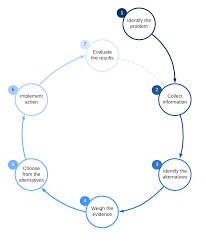Hierarchical Decision Making: Understanding the Process
Hierarchical decision making is a structured approach to making decisions that involves multiple levels of authority and input. This process is commonly used in organizations where decisions need to be made at different levels of the hierarchy.
At the top of the hierarchy are senior leaders who are responsible for making strategic decisions that impact the entire organization. These decisions are often based on long-term goals and objectives. Middle managers play a role in implementing these decisions and may have some decision-making authority within their departments.
Lower-level employees are typically involved in operational decision making, which focuses on day-to-day activities and tasks. These decisions are often more tactical in nature and help to support the overall strategic goals set by senior leadership.
Communication is key in hierarchical decision making, as information needs to flow up and down the hierarchy to ensure that all levels are informed and aligned. Feedback loops are also important to ensure that decisions are being implemented effectively and can be adjusted if necessary.
One of the main advantages of hierarchical decision making is that it provides clear lines of authority and accountability. This can help streamline the decision-making process and ensure that decisions are made efficiently.
However, hierarchical decision making can also have its drawbacks. It can be slow and bureaucratic, leading to delays in decision-making processes. It can also stifle creativity and innovation, as lower-level employees may feel limited in their ability to contribute ideas.
In conclusion, hierarchical decision making is a structured approach that involves multiple levels of authority and input. While it has its advantages in terms of clarity and accountability, it also has its limitations in terms of speed and flexibility. Organizations must carefully consider how they implement hierarchical decision-making processes to ensure they strike the right balance between structure and flexibility.
6 Essential Tips for Effective Hierarchical Decision Making
- Clearly define roles and responsibilities within the hierarchy.
- Establish effective communication channels between different levels of the hierarchy.
- Encourage feedback and input from lower levels of the hierarchy when making decisions.
- Ensure that decision-making processes are transparent and well-documented.
- Consider the expertise and perspective of individuals at each level of the hierarchy when making decisions.
- Regularly review and evaluate the effectiveness of hierarchical decision-making processes.
Clearly define roles and responsibilities within the hierarchy.
In hierarchical decision making, it is crucial to clearly define roles and responsibilities within the hierarchy. By establishing clear expectations for each level of authority, individuals can better understand their own responsibilities and how they contribute to the decision-making process. This clarity helps to streamline communication, minimize confusion, and ensure that decisions are made efficiently and effectively. When roles and responsibilities are well-defined, it fosters a sense of accountability among team members and promotes a smoother decision-making process throughout the organization.
Establish effective communication channels between different levels of the hierarchy.
To enhance hierarchical decision making, it is crucial to establish effective communication channels between different levels of the hierarchy. Clear and open communication ensures that information flows smoothly up and down the organizational structure, allowing for better coordination and alignment in decision-making processes. By fostering a culture of transparency and feedback, organizations can promote collaboration and understanding among all levels of authority, leading to more informed and successful decision outcomes.
Encourage feedback and input from lower levels of the hierarchy when making decisions.
Encouraging feedback and input from lower levels of the hierarchy when making decisions is a crucial tip in hierarchical decision making. By actively seeking perspectives and insights from employees at all levels, organizations can benefit from a diverse range of ideas and viewpoints that may not have been considered otherwise. This inclusive approach not only fosters a sense of ownership and engagement among employees but also leads to more well-rounded and informed decisions that take into account different perspectives and potential implications. Ultimately, valuing feedback from lower levels of the hierarchy can enhance the overall decision-making process and contribute to the success of organizational initiatives.
Ensure that decision-making processes are transparent and well-documented.
To effectively implement hierarchical decision making, it is crucial to ensure that decision-making processes are transparent and well-documented. Transparency helps build trust among team members and stakeholders by providing clarity on how decisions are made and who is involved in the process. Documenting the decision-making steps, rationale, and outcomes not only helps in maintaining accountability but also serves as a valuable reference for future decisions or reviews. By fostering transparency and documentation in decision-making processes, organizations can enhance communication, promote fairness, and create a culture of informed decision-making throughout all levels of the hierarchy.
Consider the expertise and perspective of individuals at each level of the hierarchy when making decisions.
When practicing hierarchical decision making, it is crucial to consider the expertise and perspective of individuals at each level of the hierarchy. Each level of the organization brings a unique set of skills, knowledge, and insights to the decision-making process. By valuing and incorporating diverse perspectives, decision makers can make more well-rounded and informed decisions that take into account the varying needs and interests of all stakeholders involved. This inclusive approach not only enhances the quality of decisions but also fosters a sense of collaboration and engagement among team members across different levels of the hierarchy.
Regularly review and evaluate the effectiveness of hierarchical decision-making processes.
Regularly reviewing and evaluating the effectiveness of hierarchical decision-making processes is crucial for ensuring that the organization is operating efficiently and effectively. By conducting periodic assessments, leaders can identify any bottlenecks or inefficiencies in the decision-making process and make necessary adjustments to improve overall performance. This proactive approach allows for continuous improvement and helps to maintain alignment between strategic goals and operational decisions at all levels of the hierarchy.




